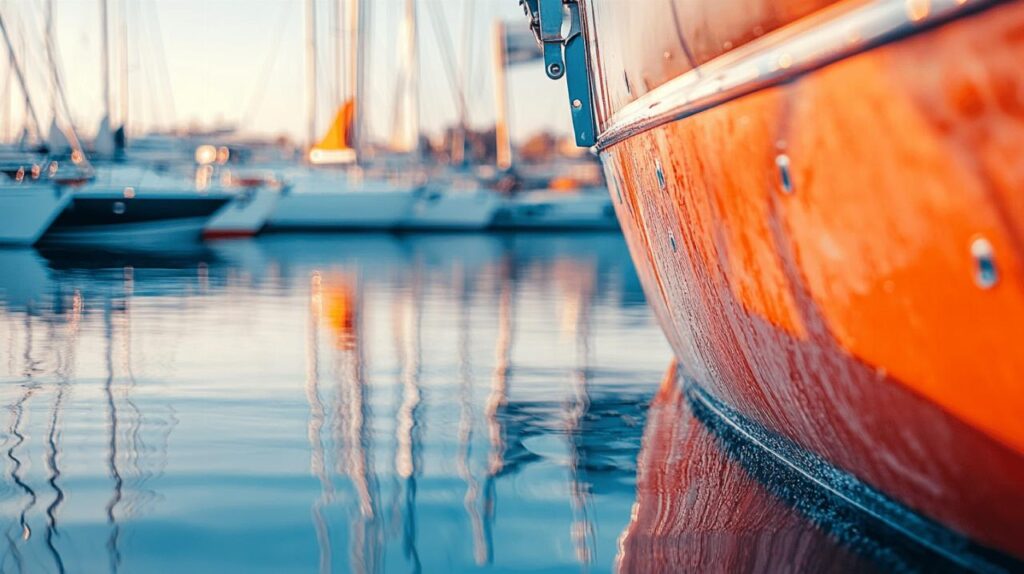Maintaining a vessel's hull is one of the most crucial aspects of boat ownership, and understanding marine fouling and its prevention is essential for any sailor. Whether you're a weekend enthusiast or a seasoned mariner, selecting the right antifouling solution can make a significant difference in your boat's performance, fuel efficiency, and overall maintenance costs. This comprehensive guide will help you navigate the sometimes confusing world of antifouling paints and techniques.
The Basics of Marine Fouling and Antifouling Solutions
What is marine fouling and why it matters to boat owners
Marine fouling occurs when organisms such as algae, barnacles, and other marine life attach themselves to a boat's hull. This natural process creates a rough surface that significantly increases drag in the water. For boat owners, this translates to reduced speed, decreased manoeuvrability, and increased fuel consumption. In fact, fouling can make engine service, sails, and rigging far less effective, compromising the vessel's overall performance. Additionally, some marine organisms can actually damage the hull material over time, leading to costly repairs if left unchecked.
Types of antifouling paints available on the market
There are several types of antifouling paints designed to address different boating needs and environmental conditions. Eroding antifouling (also known as soft or ablative) gradually wears away in water, continuously exposing fresh biocides that prevent marine growth. This type is ideal for cruising yachts and general use as it provides consistent protection and typically requires less maintenance over time. Hard film antifouling, by contrast, does not erode but rather leaches biocides while maintaining its physical structure. This makes it particularly suitable for high-speed vessels, racing boats, and craft that might spend time on drying moorings. A specialised type of eroding paint, self-polishing copolymer (SPC) antifouling, offers more controlled biocide release and becomes smoother over time, making it a premium choice for larger vessels that need extended protection. For aluminium hulls, specially formulated copper-free options are available to prevent galvanic corrosion.
Matching antifouling to your boating habits
High-performance options for frequent sailors
For active boaters who spend significant time on the water, investing in high-performance antifouling makes financial and practical sense. Products like International Micron 350, Hempel Mille NCT, Seajet 033 Shogun, or Jotun NonStop Supreme offer superior protection for cruising yachts. These premium options typically contain higher concentrations of effective biocides and utilise advanced technology to maintain their protective properties over longer periods. Racing enthusiasts might consider specialised products such as International Ultra 300, Hempel Hard Racing, or Jotun Racing, which can be sanded to an ultra-smooth finish to maximise speed. While these high-performance options typically cost between £26-£62 per litre, their enhanced durability and effectiveness often justify the higher price point for frequent sailors who would otherwise face more regular maintenance.
Cost-effective solutions for occasional boating enthusiasts
Casual boaters who only take to the water occasionally might find more economical antifouling options perfectly adequate for their needs. Products like International Cruiser 200, Hempel Cruising Performer, or Seajet 037 Coastal provide reliable protection at a more accessible price point, typically ranging from £20-£40 per litre. These formulations generally require less intensive application techniques and can be ideal for boats that spend more time moored than actively sailing. For boat owners looking to balance cost and performance, these mid-range options offer a sensible compromise without compromising essential protection. Additionally, occasional boaters might extend the life of their antifouling by performing simple maintenance such as gentle hull cleaning during the season, potentially stretching the interval between full reapplications.
Environmental factors in antifouling selection
Choosing the right formula for freshwater, brackish, or saltwater conditions
Water conditions significantly influence the effectiveness of antifouling paints. Saltwater environments typically present the most aggressive fouling challenges, requiring robust protection from products specifically formulated with higher biocide levels. Brackish water, where fresh and salt water mix, creates unique conditions that support various marine organisms, often necessitating specialised formulations that address this diverse ecosystem. Freshwater environments generally experience less intense fouling but still require protection, particularly against algae and slime. Hard antifouling paints often perform well in freshwater settings, while eroding types may be unnecessarily powerful. Understanding your primary cruising or mooring environment allows you to select an antifouling formula that provides optimal protection without excess biocides or unnecessary features, saving both money and reducing environmental impact.
Regional considerations and local regulations
Environmental regulations regarding antifouling compounds vary significantly between regions and countries, affecting which products are legally available in your area. Many places have restricted or banned certain biocides due to their environmental impact, particularly those containing tributyltin (TBT), which has been globally prohibited. Some regions have additional restrictions on copper content or other active ingredients. Before purchasing any antifouling paint, familiarise yourself with local regulations to ensure compliance. This is particularly important for boaters who travel between different jurisdictions, as what's permitted in one area might be prohibited in another. Additionally, some marinas and protected waters have their own specific requirements regarding hull maintenance and antifouling types. Manufacturers are continually developing more environmentally friendly alternatives, including biocide-free options that use physical rather than chemical deterrents, which may be worth considering in environmentally sensitive areas.
Proper application techniques for lasting protection
Surface preparation and painting best practices
 Thorough preparation is the foundation of effective antifouling application. Begin by removing old, flaking paint, which is recommended every four to five years for self-eroding types, or when the surface shows craters, flaking, or blisters. Various removal methods include dry scraping (using tools like Bahco scrapers), chemical stripping (with products such as Interstrip AF), or soda blasting. After removal, key the surface with coarse sandpaper (40-60 grit) to create a good adhesion profile. Priming is essential, especially after complete antifouling removal, as it creates a barrier between the hull and the new antifouling paint. When applying the paint itself, choose calm, dry weather conditions, stir thoroughly to ensure biocides are properly distributed, and apply at least two coats, allowing proper drying time between applications. Pay special attention to high-wear areas such as the waterline, leading edges, and rudders, applying additional coats for enhanced protection.
Thorough preparation is the foundation of effective antifouling application. Begin by removing old, flaking paint, which is recommended every four to five years for self-eroding types, or when the surface shows craters, flaking, or blisters. Various removal methods include dry scraping (using tools like Bahco scrapers), chemical stripping (with products such as Interstrip AF), or soda blasting. After removal, key the surface with coarse sandpaper (40-60 grit) to create a good adhesion profile. Priming is essential, especially after complete antifouling removal, as it creates a barrier between the hull and the new antifouling paint. When applying the paint itself, choose calm, dry weather conditions, stir thoroughly to ensure biocides are properly distributed, and apply at least two coats, allowing proper drying time between applications. Pay special attention to high-wear areas such as the waterline, leading edges, and rudders, applying additional coats for enhanced protection.
Maintenance tips to extend the life of your antifouling coating
Maximising the lifespan of your antifouling investment requires regular maintenance. Throughout the season, gently remove any accumulated slime or soft growth with a soft cloth or gentle brush while the boat is in the water – avoid aggressive scrubbing that might remove the antifouling layer itself. For boats stored out of water for extended periods, consider a freshwater rinse before storage to remove salt and marine residue. Keep detailed records of which antifouling products were used, when they were applied, and how they performed in your specific conditions to inform future decisions. For components like propellers and stern gear, consider specialised options such as lanolin/grease coatings that can be refreshed during the season. When handling antifouling paints during maintenance, always wear appropriate protective gear including gloves, eye protection, respiratory masks, and full-body covering to protect against the potentially harmful compounds. By following these practices, you can significantly extend the effective life of your antifouling coating and reduce the frequency of complete reapplications.
Choosing the Right Antifouling for Different Hull Materials
Proper antifouling selection is absolutely vital for maintaining your vessel's performance and extending its lifespan. The right antifouling paint not only protects against marine growth but also prevents damage to your hull, reduces fuel consumption, and keeps your boat looking shipshape. When selecting antifouling, you must consider your hull material, as different surfaces require specific formulations for optimal protection and compatibility.
Compatibility with fibreglass, wood, steel, and aluminium hulls
Each hull material has unique requirements when it comes to antifouling protection. For fibreglass (GRP) hulls, most antifouling paints are suitable, but proper preparation is crucial. After removing old antifouling, key the surface with coarse 40-60 grit sandpaper and apply a suitable primer to ensure proper adhesion. For wooden hulls, traditional copper-based antifouling works brilliantly, though you'll want to ensure the wood is properly sealed beforehand to prevent moisture ingress.
Steel hulls require special attention to prevent corrosion. Before applying antifouling, all rust must be thoroughly removed, voids filled with epoxy filler, and the surface primed with a quality epoxy primer. This creates a protective barrier between the metal and the antifouling paint. Aluminium hulls present a particular challenge, as they react with copper oxide – a common ingredient in many antifouling paints. For aluminium vessels, you must select copper-free formulations specifically designed for aluminium surfaces. Products labelled for aluminium compatibility will protect your hull without causing galvanic corrosion.
Special considerations for racing yachts and performance vessels
Racing yachts and high-performance vessels have different antifouling requirements than cruising boats. For these craft, every bit of drag matters, making the selection of appropriate antifouling paint critical to maintaining speed and efficiency. Hard film antifouling is typically the preferred choice for racing yachts, as it doesn't erode and creates a smooth, slick surface that can be sanded to a glass-like finish before racing.
Products such as International Ultra 300, VC Offshore, Hempel Hard Racing, or Seajet 035 Hard Racing are designed specifically for performance vessels, with price ranges from £26-£62 per litre. These formulations offer lower friction resistance while still providing effective fouling protection. Some racing-specific antifouling paints contain special additives that create an ultra-smooth surface, reducing drag and improving boat speed. For planing powerboats that regularly achieve speeds above 30 knots, hard antifouling is essential, as softer, eroding formulations would wear away too quickly at high speeds. When preparing performance vessels, extra attention should be paid to achieving a perfectly smooth finish, with additional sanding between coats if necessary for optimal performance.



